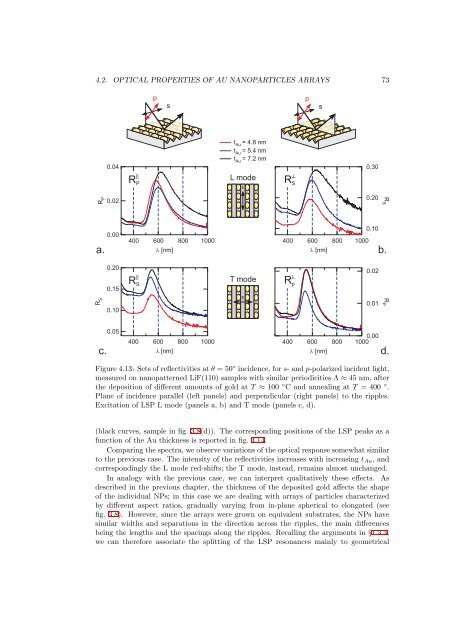Morphology and plasmonic properties of self-organized arrays of ...
Morphology and plasmonic properties of self-organized arrays of ...
Morphology and plasmonic properties of self-organized arrays of ...
Create successful ePaper yourself
Turn your PDF publications into a flip-book with our unique Google optimized e-Paper software.
4.2. OPTICAL PROPERTIES OF AU NANOPARTICLES ARRAYS 73psps0.04R P||t Au= 4.8 nmt Au= 5.4 nmt Au= 7.2 nmL modeER S┴0.30R P0.020.20RS0.004006008001000a. [nm] [nm] b.40060080010000.100.200.15R S||T modeR p┴0.02R S0.10E0.01RP0.0540060080010000.001000c. [nm] [nm] d.Figure 4.13: Sets <strong>of</strong> reflectivities at θ = 50 ◦ incidence, for s- <strong>and</strong> p-polarized incident light,measured on nanopatterned LiF(110) samples with similar periodicities Λ ≈ 45 nm, afterthe deposition <strong>of</strong> different amounts <strong>of</strong> gold at T ≈ 100 ◦ C <strong>and</strong> annealing at T = 400 ◦ .Plane <strong>of</strong> incidence parallel (left panels) <strong>and</strong> perpendicular (right panels) to the ripples.Excitation <strong>of</strong> LSP L mode (panels a, b) <strong>and</strong> T mode (panels c, d).400600800(black curves, sample in fig. 3.8(d)). The corresponding positions <strong>of</strong> the LSP peaks as afunction <strong>of</strong> the Au thickness is reported in fig. 4.14.Comparing the spectra, we observe variations <strong>of</strong> the optical response somewhat similarto the previous case. The intensity <strong>of</strong> the reflectivities increases with increasing t Au , <strong>and</strong>correspondingly the L mode red-shifts; the T mode, instead, remains almost unchanged.In analogy with the previous case, we can interpret qualitatively these effects. Asdescribed in the previous chapter, the thickness <strong>of</strong> the deposited gold affects the shape<strong>of</strong> the individual NPs; in this case we are dealing with <strong>arrays</strong> <strong>of</strong> particles characterizedby different aspect ratios, gradually varying from in-plane spherical to elongated (seefig. 3.8). However, since the <strong>arrays</strong> were grown on equivalent substrates, the NPs havesimilar widths <strong>and</strong> separations in the direction across the ripples, the main differencesbeing the lengths <strong>and</strong> the spacings along the ripples. Recalling the arguments in §1.3.3,we can therefore associate the splitting <strong>of</strong> the LSP resonances mainly to geometrical
















